2023

- Sneha Daradmare, Huiseong Son and Chang-Soo Lee
-
- "Fabrication and Morphological Control of Nonspherical Alginate Hydrogel Particles"
- Langmuir, 39, 39, 13876–13889, 19 September 2023
- We report a simple platform for the fabrication of nonspherical alginate hydrogel particles using a dripping method. Hydrogel particles with novel morphologies, such as vortex ring, teardrop, disk, sphere, and mushroom, are fabricated by controlling various parameters. We monitored the deformation process of the hydrogel particles after they penetrated the crosslinking solution using a high-speed camera. Then, we proposed a mechanism showing a unique morphological transformation from a spherical to a disk shape. We demonstrated how controlling the collecting height that causes the drop impact force against the crosslinking solution surface was critical to producing hydrogel particles with these intriguing shapes. In particular, disk-shaped alginate particles show their ability as potential platforms for culturing mouse adrenocortical tumor cells (Y1) and a hippocampal neuronal cell (HT-22). To modify alginate particles, cell-adhesive gelatin is incorporated into the alginate matrix and then alginate particles are coated with poly(allylamine hydrochloride). Two modified alginate particles show good adhesion and proliferation rates on their surfaces. In particular, the hybrid hydrogel particles provide great potential to be developed into promising materials for cell culture, drug delivery, and tissue engineering.
2022

- Sneha Daradmare and Chang-Soo Lee
-
- "Recent progress in the synthesis of all-aqueous two-phase droplets using microfluidic approaches"
- Colloids and Surfaces B: Biointerfaces, 219, 112795, 1 November 2022
- An aqueous two-phase system (ATPS) is a system with liquid-liquid phase separation and shows great potential for the extraction, separation, purification, and enrichment of proteins, membranes, viruses, enzymes, nucleic acids, and other biomolecules because of its simplicity, biocompatibility, and wide applicability [1–4]. The clear aqueous–aqueous interface of ATPSs is highly advantageous for their implementation, therefore making ATPSs a green alternative approach to replace conventional emulsion systems, such as water-in-oil droplets. All aqueous emulsions (water-in-water, w-in-w) hold great promise in the biomedical field as glucose sensors [5] and promising carriers for the encapsulation and release of various biomolecules and nonbiomolecules [6–10]. However, the ultralow interfacial tension between the two phases is a hurdle in generating w-in-w emulsion droplets. In the past, bulk emulsification and electrospray techniques were employed for the generation of w-in-w emulsion droplets and the fabrication of microparticles and microcapsules in the later stage. Bulk emulsification is a simple and low-cost technique; however, it generates polydisperse w-in-w emulsion droplets. Another technique, electrospray, involves easy experimental setups that can generate monodisperse but nonspherical w-in-w emulsion droplets. In comparison, microfluidic platforms provide monodisperse w-in-w emulsion droplets with spherical shapes, deal with the small volumes of solutions and short reaction times and achieve portability and versatility in their design through rapid prototyping. Owing to several advantages, microfluidic approaches have recently been introduced. To date, several different strategies have been explored to generate w-in-w emulsions and multiple w-in-w emulsions and to fabricate microparticles and microcapsules using conventional microfluidic devices. Although a few review articles on ATPSs emulsions have been published in the past, to date, few reviews have exclusively focused on the evolution of microfluidic-based ATPS droplets. The present review begins with a brief discussion of the history of ATPSs and their fundamentals, which is followed by an account chronicling the integration of microfluidic devices with ATPSs to generate w-in-w emulsion droplets. Furthermore, the stabilization strategies of w-in-w emulsion droplets and microfluidic fabrication of microparticles and microcapsules for modern applications, such as biomolecule encapsulation and spheroid construction, are discussed in detail in this review. We believe that the present review will provide useful information to not only new entrants in the microfluidic community wanting to appreciate the findings of the field but also existing researchers wanting to keep themselves updated on progress in the field.
2021
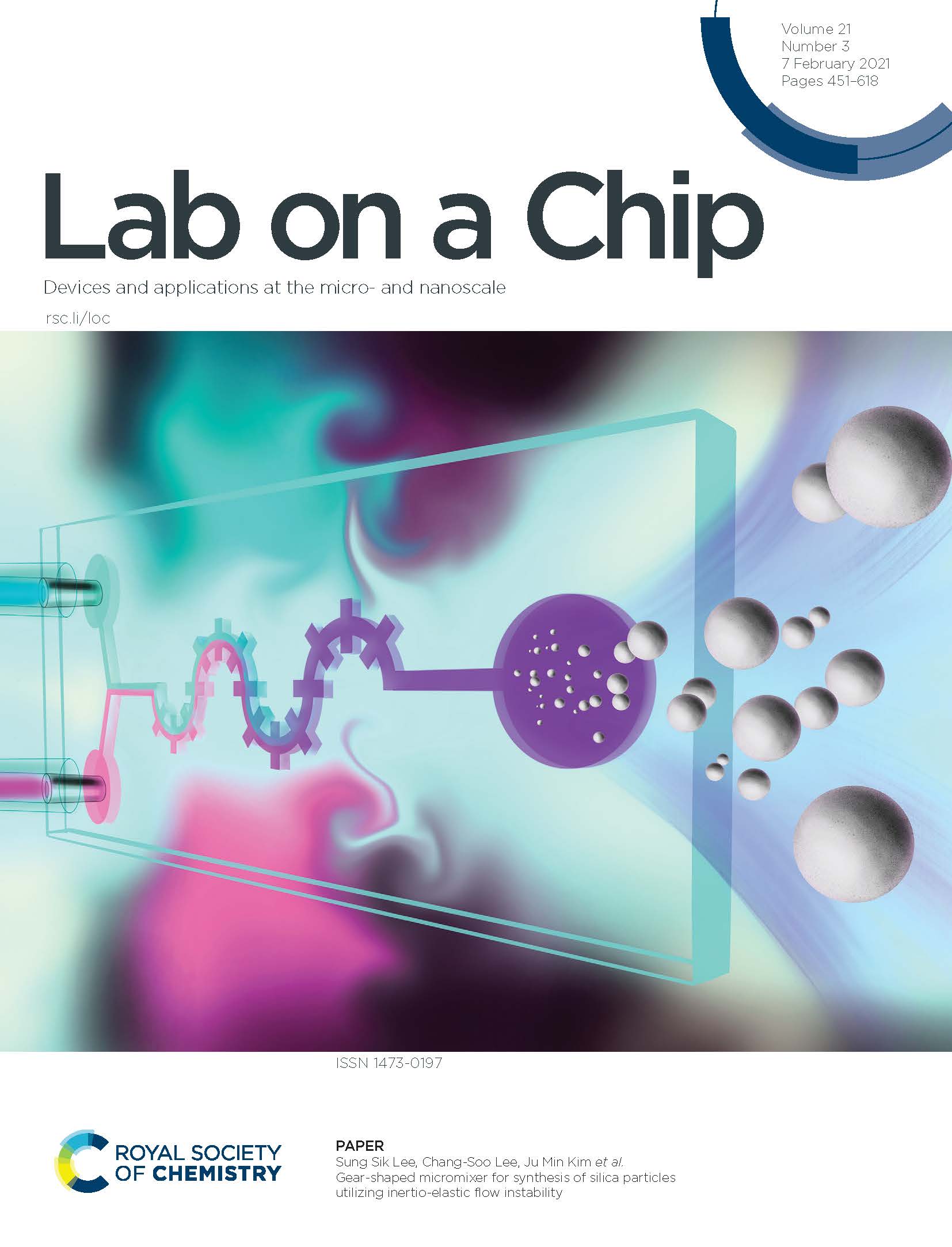
- Suk Ok Hong, Ki-Su Park, Dong-yeong Kim, Sung Sik Lee, Chang-Soo Lee, and Ju Min Kim
-
- "Gear-shaped micromixer for synthesis of silica particles utilizing inertio-elastic flow instability"
- Lab on a chip, 21, 513-520, December 2020 (Inside Front cover)
- Eukaryotic cells developed complex mitogen-activated protein kinase (MAPK) signaling networks to sense their intra- and extracellular environment and respond to various stress conditions. For example, S. cerevisiae uses five distinct MAP kinase pathways to orchestrate meiosis or respond to mating pheromones, osmolarity changes and cell wall stress. Although each MAPK module has been studied individually, the mechanisms underlying crosstalk between signaling pathways remain poorly understood, in part because suitable experimental systems to monitor cellular outputs when applying different signals are lacking. Here, we investigate the yeast MAPK signaling pathways and their crosstalk, taking advantage of a new microfluidic device coupled to quantitative microscopy. We designed specific micropads to trap yeast cells in a single focal plane, and modulate the magnitude of a given stress signal by microfluidic serial dilution while keeping other signaling inputs constant. This approach enabled us to quantify in single cells nuclear relocation of effectors responding to MAPK activation, like Yap1 for oxidative stress, and expression of stress-specific reporter expression, like pSTL1-qV and pFIG1-qV for high-osmolarity or mating pheromone signaling, respectively. Using this quantitative single-cell analysis, we confirmed bimodal behavior of gene expression in response to Hog1 activation, and quantified crosstalk between the pheromone- and cell wall integrity (CWI) signaling pathways. Importantly, we further observed that oxidative stress inhibits pheromone signaling. Mechanistically, this crosstalk is mediated by Pkc1-dependent phosphorylation of the scaffold protein Ste5 on serine 185, which prevents Ste5 recruitment to the plasma membrane.
2020
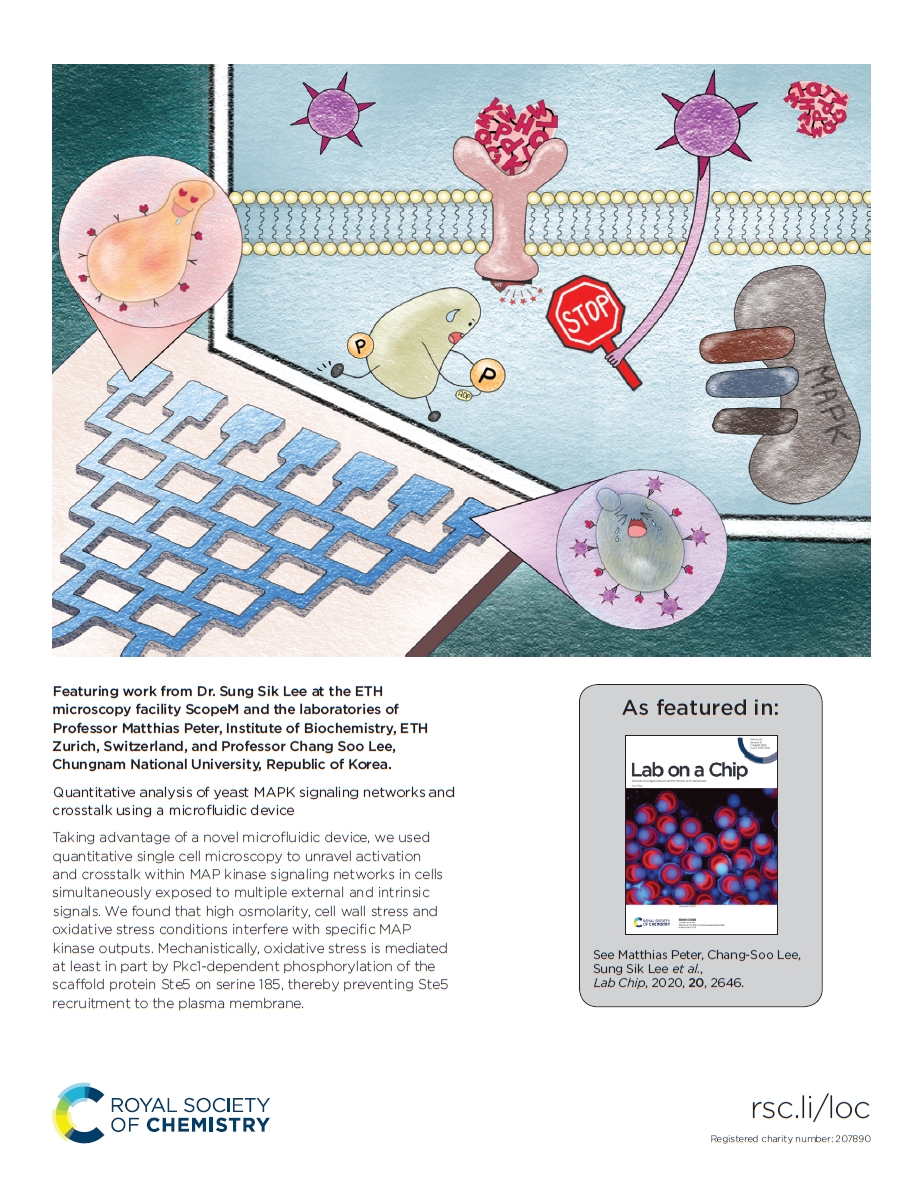
- Byungjin Lee, Seong-Geun Jeong, Si Hyung Jin, Ranjan Mishra, Matthias Peter, Chang-Soo Lee, Sung Sik Lee
-
- "Quantitative analysis of yeast MAPK signaling networks and crosstalk using a microfluidic device"
- Lab on a chip, 20, 2646-2655, 7 August 2020 (Inside Back cover)
- Eukaryotic cells developed complex mitogen-activated protein kinase (MAPK) signaling networks to sense their intra- and extracellular environment and respond to various stress conditions. For example, S. cerevisiae uses five distinct MAP kinase pathways to orchestrate meiosis or respond to mating pheromones, osmolarity changes and cell wall stress. Although each MAPK module has been studied individually, the mechanisms underlying crosstalk between signaling pathways remain poorly understood, in part because suitable experimental systems to monitor cellular outputs when applying different signals are lacking. Here, we investigate the yeast MAPK signaling pathways and their crosstalk, taking advantage of a new microfluidic device coupled to quantitative microscopy. We designed specific micropads to trap yeast cells in a single focal plane, and modulate the magnitude of a given stress signal by microfluidic serial dilution while keeping other signaling inputs constant. This approach enabled us to quantify in single cells nuclear relocation of effectors responding to MAPK activation, like Yap1 for oxidative stress, and expression of stress-specific reporter expression, like pSTL1-qV and pFIG1-qV for high-osmolarity or mating pheromone signaling, respectively. Using this quantitative single-cell analysis, we confirmed bimodal behavior of gene expression in response to Hog1 activation, and quantified crosstalk between the pheromone- and cell wall integrity (CWI) signaling pathways. Importantly, we further observed that oxidative stress inhibits pheromone signaling. Mechanistically, this crosstalk is mediated by Pkc1-dependent phosphorylation of the scaffold protein Ste5 on serine 185, which prevents Ste5 recruitment to the plasma membrane.
2016

- Si Hyung Jin, Sung-Chan Jang, Byungjin Lee, Heon-Ho Jeong, Seong-Geun Jeong, Sung Sik Lee, Keun Pil Kimd and Chang-Soo Lee
-
- "Monitoring of chromosome dynamics of single yeast cells in a microfluidic platform with aperture cell traps"
- Lab on a chip, 16, 1358-1365, 1 March 2016 (Back cover)
- Chromosome movement plays important roles in DNA replication, repair, genetic recombination, and epigenetic phenomena during mitosis and meiosis. In particular, chromosome movement in the nuclear space is essential for the reorganization of the nucleus. However, conventional methods for analyzing the chromosome movements in vivo have been limited by technical constraints of cell trapping, cell cultivation, oxygenation, and in situ imaging. Here, we present a simple microfluidic platform with aperture-based cell trapping arrays to monitor the chromosome dynamics in single living cells for a desired period of time. Under the optimized conditions, our microfluidic platform shows a single-cell trapping efficiency of 57%. This microfluidic approach enables in situ imaging of intracellular dynamics in living cells responding to variable input stimuli under the well-controlled microenvironment. As a validation of this microfluidic platform, we investigate the fundamental features of the dynamic cellular response of the individual cells treated with different stimuli and drug. We prove the basis for dynamic chromosome movement in single yeast cells to be the telomere and nuclear envelope ensembles that attach to and move in concert with nuclear actin cables. Therefore, these results illustrate the monitoring of cellular functions and obtaining of dynamic information at a high spatiotemporal resolution through the integration of a simple microfluidic platform.
2015

- Si Hyung Jin, Heon-Ho Jeong, Byungjin Lee, Sung Sik Lee and Chang-Soo Lee
-
- "A programmable microfluidic static droplet array for droplet generation, transportation, fusion, storage, and retrieval"
- Lab on a chip, 15, 3677-3686, September 2015
- We present a programmable microfluidic static droplet array (SDA) device that can perform user-defined multistep combinatorial protocols. It combines the passive storage of aqueous droplets without any external control with integrated microvalves for discrete sample dispensing and dispersion-free unit operation. The addressable picoliter-volume reaction is systematically achieved by consecutively merging programmable sequences of reagent droplets. The SDA device is remarkably reusable and able to perform identical enzyme kinetic experiments at least 30 times via automated cross-contamination-free removal of droplets from individual hydrodynamic traps. Taking all these features together, this programmable and reusable universal SDA device will be a general microfluidic platform that can be reprogrammed for multiple applications.
2013

- Chang-Hyung Choi, David A. Weitz and Chang-Soo Lee*
-
- "One Step Formation of Controllable Complex Emulsions:From Functional Particles to Simultaneous Encapsulation of Hydrophilic and Hydrophobic Agents into Desired Position"
- Advanced Materials, 18, 2535,15 May 2013
- Chang-Soo Lee and co-workers report on page 2536 the preparation of complex multiple emulsions in a single step, which provides precise control over the morphology of the droplets, the platform for synthesizing functional materials, and perfect encapsulation and compartmentalization of active ingredient into a desired position in an emulsion.
We are proud to announce the winners of our first SoftMatterWorld Calendar competition. We received submissions from all round the world and were able to select some amazing images to include in the calendar. We would like to offer any interested fellow soft matter colleagues a full color, miniature desk calendar. This offer is not limited to members of our mailing list. Any researcher, student or artist who finds these images as visually intriguing as the very science behind them is welcome to email the editor at editor@softmatterworld.org with your mailing address and we will gladly send you a copy.
February 2013
Adam Ossowski
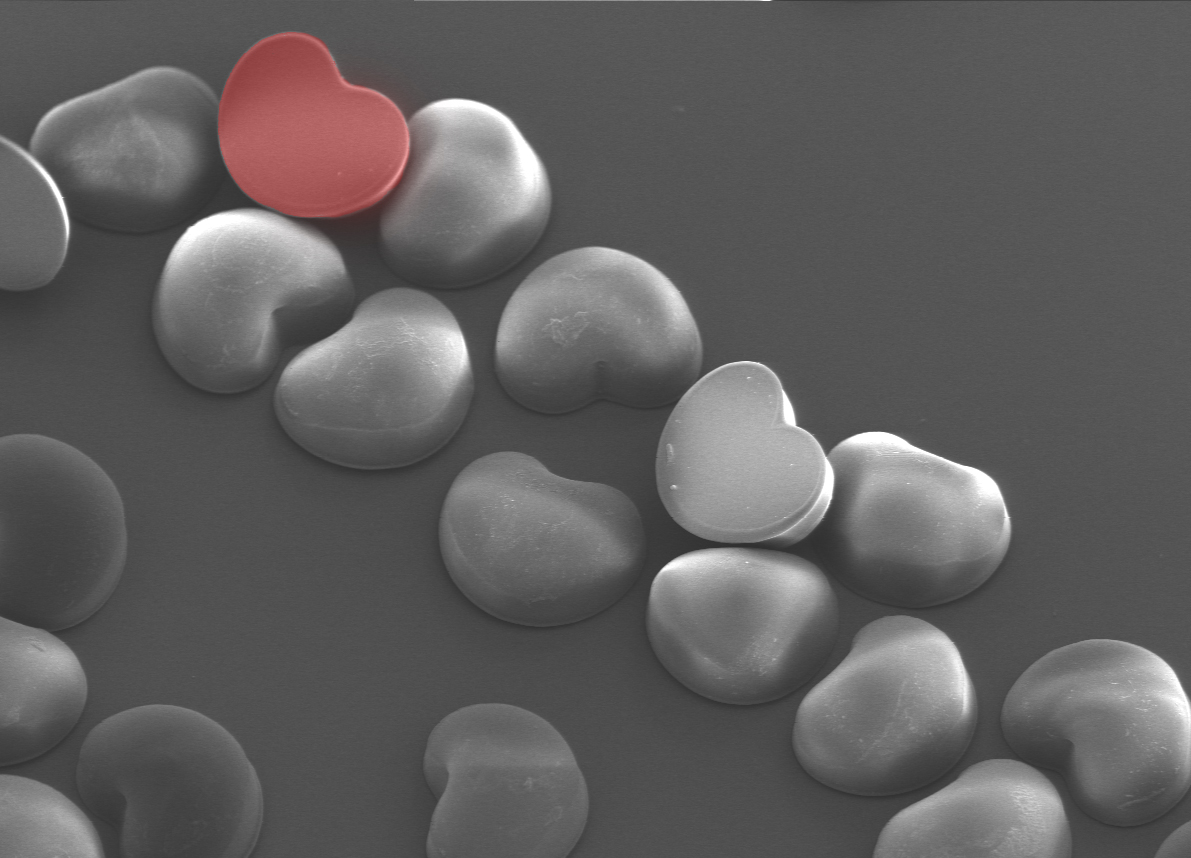
Plastic Love ( Chang-Soo Lee )
We have presented a novel approach for the generation of anisotropic particles through surface tension induced flow beyond conventional replica molding techniques. This proposed methodology for the synthesis of anisotropic particles can be applied for novel material synthesis in a wide variety of applicationis such as photonics, liquid crystals, and optics. Specifically, anisotropic particles can be used as elemental building block to construct highly complex architecture for decelopment of functional materials. The particles can also be sued in new applications iin advanced materials, which take advantage of their unique scattering properties as well as precise control over shape and size. Chungnam national university, South Korea
2012

- Chang-Hyung Choi, Jae-Min Jeong, Sung-Min Kang, Jinkee Lee*, and Chang-Soo Lee*
-
- "Synthesis of monodispersed microspheres from laplace pressure induced droplets in micromolds"
- Advanced Materials, 24, 5077, 18 September 2012
*Corresponding author
- A novel synthesis method for microspheres using micromolds based on the Laplace pressure difference is presented by Jinkee Lee, Chang-Soo Lee, and co-workers on page 5078. This simple micromolding technique makes it possible to synthesize highly monodispersed microspheres with the flexibility of various reaction schemes, such as photopolymerization, sol-gel reactions, and colloidal assembly. This method is promising for the mass production of various sizes of monodispersed microspheres without the need for complicated control of fluids

- Heon-Ho Jeong, Yun-Gon Kim, Sung-Chan Jang, Hyunmin Yi and Chang-Soo Lee
-
- "Profiling surface glycans on live cells and tissues using quantum dot-lectin nanoconjugates"
- Lab on a chip, 12, 3290-3295, 21 September 2012
- The surface of mammalian cells is densely coated with complex glycans, which are directly involved in cell–cell or cell–protein interactions that trigger various biological responses. Here, we present a novel glycomics approach that uses quantum dot (Qdot)-lectin nanoconjugates to interrogate the surface glycans of tissues and patterned cells. Our approach allows highly sensitive in situmonitoring of specific lectin–glycan interactions and quantitative information on surface glycans for each examined cell line and tissue. The results clearly show significant changes in glycosylation for each cell line and tissue sample. We expect that these results will be applicable in cancer diagnostics and promote the development of new analytical tools for glycomics.
2011
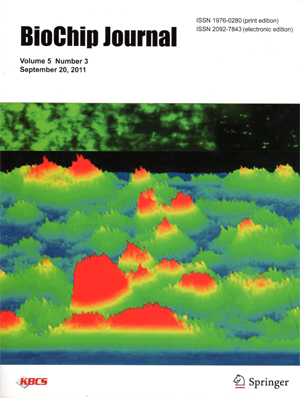
- Aeri Park, Heon-Ho Jeong, Jintae Lee, Keun Pil Kim and Chang-Soo Lee
-
- "Effect of shear stress on the formation of bacterial biofilm in a microfluidic channel"
- BIOCHIP JOURNAL, 5, 236-241, 20 September 2011
- Biofilms form an irregular network matrix that is surrounded by extracellular polymeric substrate (EPS). The architecture of biofilm plays an important role in protecting bacteria under physical, chemical, and biological stress. The shear stress is one of the major factors to construct stable bioflim. The experimental observation of biofilm formation on large-scale water flow has been limited because most of fluid pipe are water and sewer lines. This study presents the biofilm formation in a PDMS-based microfluidic channel which is able to simulate fluid pipes at small scale. We could characterize the hydrodynamics of the growth of single-species bacteria between biofilm formation and the external environmental factors. Particularly, the dynamics of biofilm formation confirms that biofilm, under the optimum shear stress, efficiently form a stable EPS structure which provides a mechanical shield against high-pressure fluidic flow.
2009
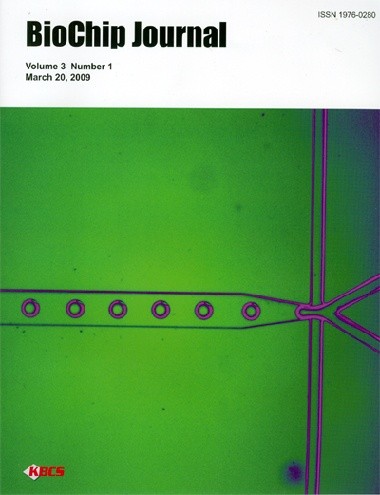
- Jae-Hoon Jung, Chang-Hyung Choi, Taek-Sung Hwang, Chang-Soo Lee
-
- "Efficient In situ Production of Monodisperse Polyurethane Microbeads in Microfluidic Device using Increase of Residence Time of Droplets"
- BIOCHIP JOURNAL, 3, 44-49, March 2009
- This study presents a simple method for the efficient generation of monodisperse polyurethane (PU) microbeads in microfluidic device integrating with downward outlet to increase the residence time of droplets on the UV irradiating area. Based on the mechanism of shear force-driven break-off, monodisperse droplets of acrylated urethane as an oil-in-water (O/W) emulsions are continuously generated in an immiscible continuous phase at the cross-shaped junction.The droplets of oligomeric PU as a dispersed phase are rapidly polymerized at downward outlet channel by in situ UV polymerization. The low coefficient of variance (CV, 1%) indicates that the produced microbeads have narrow size distribution. In addition, the size of microbeads produced can be controlled by important operating parameters such as flow rates of continuous and dispersed phase. Therefore, the proposed in situ microfluidic method provides a novel route for the synthesis of monodisperse microbeads via a one-pot synthetic approach.



